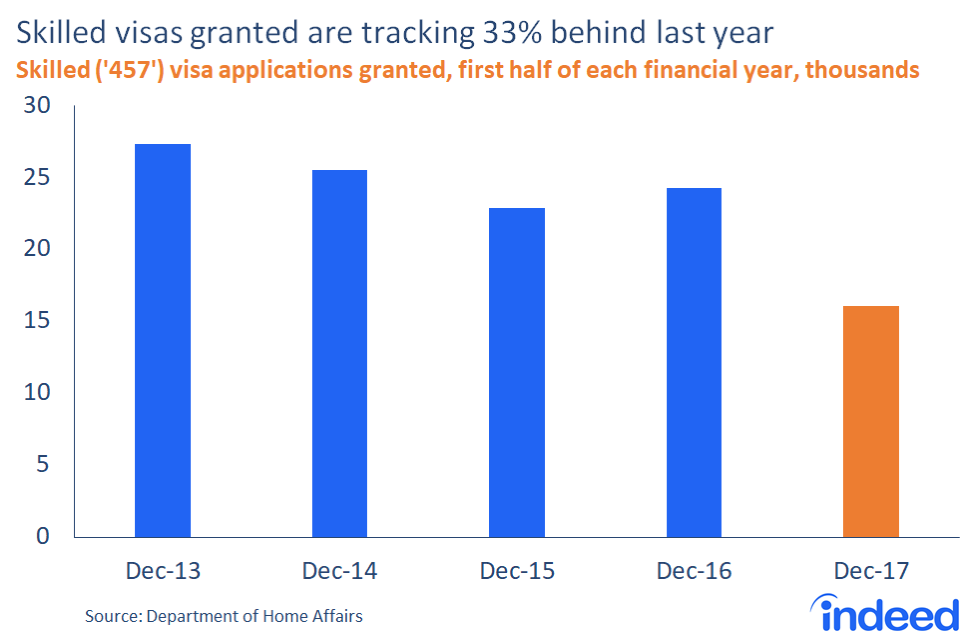Key points:
- Between July and December 2017, the number of temporary skilled 457 visas granted declined by one-third compared with the same period a year earlier.
- Visa grants have fallen across all industry and age groups.
- Nevertheless, overseas job seekers have significantly stepped up searches for work in Australia.
It has been almost a year since the federal government announced sweeping changes to Australia’s temporary skilled visa program, known as the 457 visa program. These reforms, which include banning specific occupations from the program, setting higher standards for English language competency and putting up greater barriers to permanent residency, originally appeared relatively small in scope. Today though, we have a sense of the impact of these changes, and relatively small they are not.
Despite rising interest in Australian jobs from overseas, the number of skilled visas awarded has fallen sharply, creating concerns among businesses that the program fails to address their concerns about skill shortages. The decline was broadly based across industries, hitting established and emerging occupations alike, and falling across every age group.
Analysing the latest immigration figures and Indeed data on job search activity, we found the following:
- The number of 457 visas granted from July to December 2017 dropped by one-third compared with the same period a year earlier.
- No industry was untouched. Grants to professionals and hospitality workers both fell 37%, while grants to the retail sector fell 45%. Grants to utilities workers declined least, falling just 8%.
- Despite the reforms, foreign interest in Australian jobs remains high. Overseas job seekers accounted for 8.1% of search activity for Australian positions in 2017, up from 6.4% a year earlier.
Skilled migration takes a tumble
Through the first six months of the 2017-18 financial year, the federal government awarded 16,058 primary 457 visas, compared with 24,270 visas granted over the same period a year earlier, a 34% decline.
The 457 visa program gives foreign workers the right to work in a specific occupation in Australia for up to four years. Most applicants are sponsored by an employer seeking to fill a specific role. The program has long been a popular pathway to permanent residence. For more on the nature and characteristics of the 457 visa programme, click on the link.

The decline in visas granted during the 2017-18 financial year is roughly twice what we projected following announcement of the reforms. Based on historical trends, we estimated the federal government’s decision to ban nearly 200 occupations from the 457 visa program would reduce 457 grants 7-9% annually, while the 45-year-old age limit would cut applications 6-8% annually.
The reality has been different. Grants have fallen across every industry group. Skilled visas awarded to professional services, the biggest employer of skilled migrants, are down 37% compared with the first half of the 2016-17 financial year. Visas granted to the hospitality sector are also down 37%, while visas for the retail sector fell 45%.
The technology sector has also been hit hard. The number of visas for developer programmers fell 31%, software engineers 10% and analyst programmers 50%. Tech companies, including Atlassian and its Australian founder Scott Farquhar, have strongly criticised these reforms. It’s easy to see why. Skilled tech workers are in high demand globally, and have choices about where to live and work.
In response to concerns from the tech industry in Australia, the federal government has announced a ‘Global Talent Scheme’ trial program, commencing 1 July, designed to make it easier to hire experienced tech talent from other countries. It applies only to STEM (science, technology, engineering and mathematics) based firms and employers must demonstrate that there will be a skills transfer to local workers as a result of the overseas job seeker receiving a visa.

Grants fell sharply across every age group. Those awarded to applicants between 25 and 44 are estimated to have sunk 29% in 2017-18, while awards to those 45 and older plunged 37%. The number of grants to job seekers over 45 will likely fall further when the program morphs into the Temporary Skilled Shortage visa program.
Grants to workers from India, the United Kingdom, the United States and the Philippines all fell around one-third compared with same period in 2016-17. Grants to China tumbled 46%, while French and Japanese awards were down 23% and 26% respectively.
Foreign interest remains high
The decline in 457 visas granted hasn’t cooled foreign interest in Australian jobs. It’s actually higher today than it was when the reforms were announced in April a year ago. In 2017, overseas searches of Australian job posts rose around a quarter compared with a year earlier. And searches by overseas job seekers using migration-related terms, such as ‘visa’ and ‘457’, have tripled since 2015.
Job seeker interest is certainly there and, if the Australian business sector had its way, so too would be the jobs. But the process of moving from job seeker to skilled migrant has become slower and more arduous. What is more, limited pathways to permanent residence may encourage overseas job seekers to look elsewhere.

A divergence between job seeker interest and work opportunities creates a risk that skill shortages will emerge and persist. For example, long-term shortages are evident in nursing, yet the number of nurses on skilled visas has fallen two-thirds since its peak in 2013. Meanwhile, the tech industry faces trouble on two fronts: Not only does it face skill shortages, but it frequently needs workers who don’t fall neatly into any of the existing skilled migration occupation categories. The announcement of the ‘Global Talent Scheme’ may help but with few details available it is unclear whether it will have a large impact on skilled visas granted to the tech sector.
